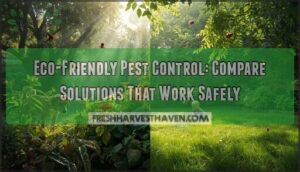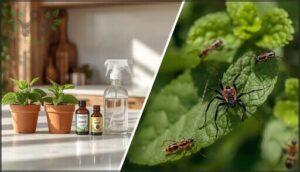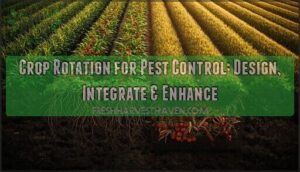This site is supported by our readers. We may earn a commission, at no cost to you, if you purchase through links.
Traditional pesticides kill more than just pests—they disrupt entire ecosystems, contaminate groundwater, and leave residues that persist in your home for months. You spray for ants, and suddenly the bees in your garden disappear. You treat your lawn, and your dog develops unexplained symptoms. The collateral damage adds up quickly.
Environmentally friendly pest control solutions take a different approach, targeting specific pests while protecting the organisms that keep your yard and home in balance. These methods range from botanical oils that repel rather than poison, to beneficial insects that hunt problem species naturally.
The shift isn’t just about feeling better—it’s backed by data showing 70-80% effectiveness rates with virtually zero toxic exposure. When you understand how these alternatives work and which situations call for each approach, you can make informed decisions that protect both your property and the broader environment around it.
Table Of Contents
- Key Takeaways
- Why Choose Eco-Friendly Pest Control?
- Comparing Natural and Organic Pest Solutions
- Integrated Pest Management (IPM) Approaches
- Eco-Friendly Solutions for Common Pests
- Cost, Effectiveness, and Environmental Impact
- Frequently Asked Questions (FAQs)
- How do eco-friendly pest products compare in cost?
- Can green pest control work in severe infestations?
- How long do natural pest treatments typically last?
- Are DIY eco-friendly methods as effective as professional?
- What certifications should I look for in providers?
- Can eco-friendly pest control be used in apartments?
- Are green pest solutions safe for aquatic environments?
- What are the storage requirements for natural pesticides?
- Conclusion
Key Takeaways
- Eco-friendly pest control methods target specific pests, protect beneficial organisms, and reduce health risks for families and pets compared to traditional pesticides.
- Integrated Pest Management (IPM) combines prevention, monitoring, mechanical barriers, and biological controls to achieve 70–95% pest suppression with minimal resistance development.
- Natural solutions like botanical oils, essential oils, and beneficial insects offer comparable effectiveness to chemicals, break down quickly, and support long-term ecosystem health.
- While green pest control may cost more upfront, it delivers lasting savings, fewer hidden expenses, and significantly lower environmental impact over time.
Why Choose Eco-Friendly Pest Control?
When you’re dealing with pests, the methods you choose affect more than just the bugs—they impact your family’s health, your local ecosystem, and the long-term balance of your property.
Traditional pesticides might offer quick fixes, but they often come with hidden costs that show up in soil contamination, harm to beneficial insects, and potential health risks.
Let’s look at why eco-friendly pest control offers a smarter path forward for protecting what matters most.
Health and Safety for Families and Pets
Peace of mind starts when you know your home won’t harm the ones you love. Traditional pesticides carry real health risks—children exposed to indoor insecticides face a 47% higher leukemia risk, while 33% of cats show unsafe pesticide levels.
Traditional pesticides expose children to a 47% higher leukemia risk and leave unsafe residues in one-third of cats
Chemical-free, nontoxic pest control protects your family from these dangers. Pet safe and kids safe alternatives eliminate toxic residues without sacrificing effectiveness, giving you genuinely safe protection.
Families can also implement preventative measures, such as sealing all entry points to block pest access.
Reducing Environmental Impact
Your choice protects more than just your home—it shapes the world around you. Eco-friendly pest control slashes carbon footprint by over 70%, preventing water contamination and soil degradation that synthetic pesticides cause.
You’ll help reverse biodiversity loss while supporting waste reduction through targeted treatments that don’t poison waterways or harm beneficial insects.
Sustainable pest control methods deliver environmental sustainability without compromise, proving that environmentally friendly pest control works. You can also use natural pest repellents like essential oils.
Long-Term Sustainability and Effectiveness
Beyond immediate environmental benefits, you’ll see genuine long-term results. Integrated pest management techniques deliver 70-95% pest suppression while building lasting ecosystem health. These sustainable pest control methods slash pest resistance development because they target root causes—not just symptoms.
Eco-friendly pest control services combine IPM sustainability with innovation enhancement, proving environmental outcomes match economic viability. Your investment protects families for years, not just weeks, through strategic long-term maintenance strategies.
Certifications and Green Standards
When selecting eco-friendly pest control services, look for recognized certifications that verify genuine green principles. GreenPro certification—awarded by the EPA after meeting strict integrated pest management standards—ensures providers minimize pesticide exposure through habitat modification and exclusion. Green Shield Certified programs take it further, prohibiting routine chemical applications entirely.
These certification benefits include documented performance monitoring and sector requirements customized to food safety, healthcare, or agriculture. Standard evolution now emphasizes impact measurement, proving environmentally friendly pest control delivers both ecological protection and measurable results you can trust.
Comparing Natural and Organic Pest Solutions
When you’re ready to move beyond conventional pesticides, you’ll find a range of natural and organic solutions that work differently but share a common goal: controlling pests without harming your family or the environment.
Each approach has its own strengths, from plant-based formulas you can apply directly to living organisms that do the work for you.
Let’s compare the main categories so you can choose what fits your situation best.
Plant-Based Repellents and Essential Oils
When you’re looking for natural pest control that really works, essential oils and plant-based solutions offer impressive results backed by solid science. These natural repellents and deterrents utilize chemical components like citronellal and geraniol, delivering environmental benefits without synthetic pesticide risks.
Consider what research shows about oil efficacy and safety concerns:
- Patchouli oil blocks mosquitoes for 120 minutes with 100% protection in lab tests
- Citronella provides complete repellency for 20 minutes when applied to skin
- Palmarosa oil protects against malaria mosquitoes for 12 hours in field conditions
- Coconut compounds exceed DEET’s performance against stable flies with over 95% effectiveness
- The natural insecticides market hit $726 million in 2024, growing 7.9% annually through 2030
Market trends reflect your growing preference for plant-based solutions that don’t compromise safety. You’ll find these natural insecticides break down naturally, protecting waterways and wildlife while controlling pests effectively.
Biological Controls and Beneficial Insects
Predator introduction takes natural pest control beyond essential oils—you’re enlisting living allies like ladybugs and parasitic wasps. Biocontrol efficacy is striking: these beneficial insects reduce pest abundance by 63% while boosting yields over 60%.
Insect compatibility matters for ecosystem impacts, as these natural enemies increase biodiversity by 43% compared to synthetic options. This integrated pest management approach also strengthens resistance prevention, since pests can’t easily outsmart nature’s diverse arsenal.
DIY Organic Sprays and Herbal Remedies
You can mix your own pest deterrents using neem oil, essential oils like peppermint or clove, and herbal remedies such as garlic spray.
DIY organic sprays deliver 77–85% effectiveness when you combine ingredients like neem with pyrethrin, though you’ll need to reapply them three to five times per season.
These homemade solutions minimize environmental impact and safety concerns while keeping costs low.
Botanical Vs. Synthetic Pesticides
Botanical pesticides like neem oil, pyrethrin, and essential oils offer compelling advantages over synthetic chemical pesticides when you weigh environmental impact, health risks, and long-term efficacy.
Consider these key differences:
- Health risks: Only 3% of botanical substances carry hazard warnings versus 55% of synthetic pesticides
- Environmental impact: Botanicals degrade in 2–7 days compared to 10–45 days for synthetics
- Efficacy comparison: Botanicals reduce pests 70–80% while supporting beneficial insects
- Economic factors: Costs overlap at $22–$70 per hectare, but botanicals prevent resistance buildup
- Regulatory trends: Botanicals enjoy 82% fast-track approval rates reflecting their safety profile
You’ll find botanicals maintain soil health better and protect pollinators while delivering sustainable pest control.
Integrated Pest Management (IPM) Approaches
Integrated Pest Management isn’t about reaching for one magic solution—it’s about creating a system where different strategies work together to keep pests under control. Think of it as building layers of defense, from stopping pests before they arrive to using physical barriers and combining methods that complement each other.
Here’s how you can put IPM principles into practice in your own space.
Prevention and Monitoring Strategies
Think of pest prevention like maintaining your health—early detection beats crisis management every time. You’ll want to start with sanitation practices: removing food debris and grease cuts pest attraction by 70%. Habitat modification matters too—sealing cracks reduces pest entry by 60-80%, while fixing leaky faucets eliminates breeding sites.
Pest monitoring through sticky traps and pheromone devices gives you the data-driven decisions that make Integrated Pest Management work. These tools capture crawling pests with 85% efficiency and detect moths 60% earlier than visual checks alone. Remote sensors now provide real-time pest activity updates, slashing manual inspection time by 70% while catching problems before they escalate.
Here’s how prevention strategies compare in practical terms:
| Prevention Method | Pest Reduction Impact |
|---|---|
| Sanitation practices | Up to 70% fewer pests |
| Sealing entry points | 60-80% reduced ingress |
| Moisture control | 50% lower breeding risk |
| Vegetation management | 40% decreased entry likelihood |
| Natural repellent barriers | 30-45% less chemical use |
Educational strategies boost your success—homeowners who learn pest identification and habitat management see 35-50% better adoption of natural pest control methods. Community-based monitoring networks catch invasive species early, reducing outbreak spread by 45%. This collective knowledge transforms pest management strategies from reactive fumigation to proactive environmental sustainability.
The beauty of threshold-based interventions? You intervene only when pest populations actually threaten damage, cutting unnecessary pesticide applications by 65% while potentially boosting yields by 15%. Decision-support systems that combine your monitoring data with weather patterns increase control effectiveness by 30%, proving that smart pest prevention protects both your home and the planet.
Mechanical and Physical Pest Controls
Physical mechanical controls offer immediate pest elimination without toxic residues—traps, barriers, and exclusion methods that pests can’t outsmart through resistance. You’ll appreciate how these solutions fit seamlessly into IPM integration strategies: stainless steel mesh barriers protect homes for 20-50+ years, sticky traps capture 85% of crawling pests, and mass trapping disrupts reproductive cycles.
Urban applications prove particularly effective—single-visit IPM strategies combining mechanical controls noticeably reduced cockroach populations while supporting barrier durability and resistance prevention.
Combining Multiple Eco-Friendly Methods
When you pair methods strategically, you reveal synergistic effects that single tactics can’t match. Integrated programs combining beneficial insects with botanical sprays reduce infestations by 40–60%, while habitat manipulation supporting natural predators cuts chemical needs by 20–40%. Add technological integration through IoT monitoring, and you’ll refine timing for biological control. Don’t overlook sanitation barriers—removing debris before applying natural pest control methods enhances IPM effectiveness by up to 50%.
| Method Combination | Pest Reduction |
|---|---|
| Biocontrol + Botanicals | 40–60% |
| Habitat + Sanitation | 30–70% |
| IoT + Precision Application | 35% pesticide cut |
Case Studies in Sustainable IPM
Combine eco-friendly tools, and you quickly see proof in the field. Case studies highlight how Integrated Pest Management (IPM) boosts yields, brings economic benefits, and builds biodiversity.
With approaches like biological control and monitoring, farms report stronger social impact and greater resilience—showing Sustainable Pest Management isn’t just a theory, but a collection of real-world success stories and sustainable innovations driving lasting change.
Eco-Friendly Solutions for Common Pests
When pests show up in your home or garden, you don’t have to reach for harsh chemicals to solve the problem. Eco-friendly methods can effectively target specific invaders while keeping your family, pets, and the environment safe.
Let’s look at practical solutions for the most common pests you’re likely to encounter.
Ants, Roaches, and Spiders
When dealing with ants, roaches, and spiders, you’ll find natural repellents like peppermint oil and plant-derived sprays reduce infestations by 70–80% while protecting beneficial insects. Prevention methods—sealing entry points and maintaining sanitation—form your first line of defense in ecofriendly pest control.
Biological controls using nematodes target specific pests without harming pets, and smart traps with AI monitoring improve accuracy. Organic roach control formulations have eliminated over 150 roaches in controlled studies, proving natural pest control works.
Fleas, Ticks, and Bed Bugs
Fleas, ticks, and bed bugs require targeted natural pest control methods that protect your family while minimizing environmental impact. Plant-based supplements show up to 82% efficacy against fleas after five months, while botanical repellents using cedar and neem oil work effectively as IPM strategies.
Consider these eco-friendly pest control services:
- Essential oils (geraniol, eugenol) alter bed bug behavior patterns considerably
- Diatomaceous earth creates physical barriers without chemical residues
- Beneficial insects and microbial agents reduce populations naturally
- Cedar tar alternatives eliminate flea infestations safely
- Market trends show growing demand for botanical-based solutions
Remember, conventional treatments containing imidacloprid can kill 60 million bees from one dog treatment—making biological controls and neem oil applications safer choices for sustainable pest management.
Termites and Rodents
Termites and rodents demand effective eco-friendly pest control strategies that safeguard your home without toxic residues. Natural pest control options like borate wood preservation and beneficial nematodes target termite colonies effectively, while rodent exclusion through sealing entry points paired with peppermint oil repellents keeps invaders at bay. Diatomaceous earth creates lasting barriers, and termite baits using botanical oils provide sustainable solutions—75% of companies now offer these natural alternatives.
| Pest | Eco-Friendly Method | Effectiveness |
|---|---|---|
| Termites | Nematodes & Borate | High with reapplication |
| Termites | Orange Oil Spot Treatment | Immediate contact kill |
| Rodents | Exclusion & Natural Repellents | 100% with proper sealing |
Garden and Crop Pest Management
In your garden, you’ll achieve up to 85% pest reduction through integrated approaches that work with nature. Crop rotation and companion planting disrupt pest life cycles while building soil health, and natural predators like ladybugs handle the rest—reducing pest damage by over 50% in organic gardening systems.
Water management and beneficial insects complete this effective strategy, protecting your crops without synthetic chemicals.
Cost, Effectiveness, and Environmental Impact
When you’re weighing eco-friendly pest control against conventional methods, three questions usually come up: What will it cost me? Will it actually work? And what happens to my family and the environment?
The answers aren’t always straightforward, because green solutions often play the long game while traditional pesticides promise quick fixes.
Let’s break down how these approaches stack up across price, performance, and the bigger picture of health and environmental impact.
Price Comparison: Green Vs. Conventional Methods
When you’re weighing pest control options, understanding the financial picture matters for both your budget and your values. Here’s what shapes the cost comparison between green pest control and conventional pesticides:
- Initial Investment: Eco friendly pest control services generally require 15-30% higher upfront costs, with home setups ranging from $100 to $500 versus $20 to $50 for chemical pesticides
- Long-Term Costs: Natural methods average $100-$300 annually per acre for maintenance, compared to $200-$600 for chemical pest control services that need frequent reapplication
- Hidden Expenses: Conventional pesticides carry costs you mightn’t see initially—protective equipment ($50-200 yearly), storage facilities ($200-500), and potential environmental cleanup (up to $5,000 per incident)
- Specific Methods: Neem oil costs $10-30 per acre with 75-85% effectiveness, while microbial biopesticides run $18-30 per acre and achieve 75-90% pest reduction
- Market Implications: The U.S. pest control market is projected to reach $32.8 billion by 2028, with green methods showing favorable return on investment after 2-3 growing seasons
You’ll find that while natural pest control demands more upfront, it sidesteps the recurring costs and risks that come with synthetic pesticides.
Efficacy and Resistance Management
You want pest control that keeps working year after year without becoming another headache. Eco-friendly methods shine here, achieving 70% pest reduction through integrated pest management (IPM) while pests develop resistance to these biological controls at rates below 10%—compared to over 60% resistance to synthetic pesticides.
| Pesticide Alternatives | Long-Term Efficacy | Resistance Prevention |
|---|---|---|
| Neem oil & botanical options | 65-75% reduction | <10% resistance development |
| Natural predators (biological control) | 70%+ population control | Minimal resistance signs |
| IPM effectiveness (combined strategies) | 70% sustained control | 15-20% after 5-7 seasons |
| Pheromone traps | 85% monitoring success | Near-zero resistance |
| Habitat manipulation | 50% chemical reliance reduction | 2-3x extended lifespan |
Botanical resistance remains remarkably low even after multiple growing seasons, while integrated approaches maintain pest populations comparable to chemicals without the resistance spiral that undermines conventional methods over time.
Environmental and Health Outcomes
Your family’s exposure to toxic chemicals drops dramatically with eco-friendly living—organic pesticides carry 97% fewer health risks than synthetics. You’ll protect pollinators while cutting soil degradation and waterway protection concerns, as nontoxic pest control eliminates VOCs that affect indoor air quality.
The environmental impact of pest control shrinks considerably, reducing chronic disease risks tied to conventional pesticide exposure while preserving beneficial ecosystems.
Innovations and Trends in Green Pest Control
You’ll see green pest control products transform through smart traps with IoT sensors that alert you instantly to infestations. Biopesticides using RNA interference target specific pests without harming beneficial insects, while AI-driven pest forecasting facilitates preemptive natural pest management solutions.
Integrated Pest Management (IPM) now combines drone surveillance with ecofriendly solutions and green technology, making sustainable pest control more precise and effective than conventional methods.
Frequently Asked Questions (FAQs)
How do eco-friendly pest products compare in cost?
Like planting a garden, investing in eco-friendly pest products means you’ll face higher upfront costs compared to conventional solutions.
Over time—thanks to long-term savings, reduced hidden costs, and resilient efficacy—your investment yields healthier, enduring returns.
Can green pest control work in severe infestations?
Green effectiveness in severe infestations often requires IPM approaches and combining EcoFriendly Pest Control Methods. Real-world evidence shows natural strategies work, but infestation challenges include slower results, recurring treatments, and cost considerations—key disadvantages of green pest management for persistent pest infestations.
How long do natural pest treatments typically last?
Natural pest treatments aren’t forever—some last just a week, others up to 90 days, depending on environmental influence, reapplication frequency, and pest resistance.
Treatment longevity factors and preventative practices drive results in organic, ecofriendly pest control options.
Are DIY eco-friendly methods as effective as professional?
DIY Effectiveness depends on infestation severity; for small issues, DIY natural pest control recipes and strategies work well. Larger problems often need professional expertise for long-term control.
Green pest control services cost more but offer better benefits of green pest management.
What certifications should I look for in providers?
When choosing Green Pest Control Services, look for GreenPro benefits, Green Shield, USDA Organic standards, LEED compliance, or PESP program recognition.
These certifications guarantee providers meet rigorous environmental, safety, and Organic Pest Management standards in the Pest Control Industry.
Can eco-friendly pest control be used in apartments?
Absolutely, eco-friendly pest control works well in apartments. Apartment IPM combines monitoring, nontoxic pest control, and pet safe pest control methods.
These EcoFriendly Solutions reduce environmental impact, align with renter preferences, and integrate natural pest control products for indoor safety.
Are green pest solutions safe for aquatic environments?
Did you know some green pest solutions, like pyrethrins, still cause acute aquatic toxicity? While Low Toxicity Products and regulatory standards help, runoff impact remains a concern.
Innovation research aims to balance biological pest control with true environmental sustainability in pest control.
What are the storage requirements for natural pesticides?
Store natural pesticides like Diatomaceous Earth, Neem oil, and Boric acid in original containers, away from sunlight, between 40°F–90°F.
Prioritize temperature control, container integrity, safety measures, and stock rotation to extend shelf life and product effectiveness.
Conclusion
Picture two yards: one silent, stripped of life by harsh chemicals; the other humming with bees, birds, and healthy pets, thanks to environmentally friendly pest control solutions. The difference isn’t just visible—it’s tangible in every breath, every footprint, every harvest.
Choosing eco-friendly methods means you’re not just solving a problem; you’re nurturing a living system. When you weigh your options, remember that real safety and effectiveness grow best where nature and knowledge work hand in hand.
- https://ipm.ucanr.edu/agriculture/floriculture-and-ornamental-nurseries/managing-pesticide-resistance/
- https://www.xerces.org/pesticides/risks-pesticides-pollinators
- http://npic.orst.edu/factsheets/petspest.html
- https://www.forbes.com/home-improvement/pest-control/natural-pest-control-solution/
- https://www.epa.gov/caddis/insecticides











